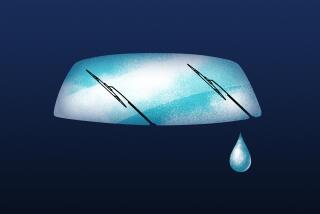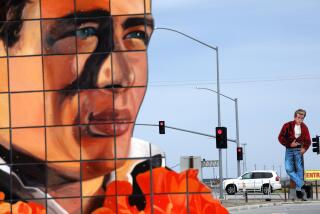Hot Rodders Take Route Into ‘50s, Retrace Dean’s Final Drive
- Share via
‘He’s gotta see us. He’s gotta stop.’--James Dean’s last words
There they stood, teen-age boys in faded Levis, white T-shirts, white socks, pointed-toe shoes and light Windbreakers, propped casually against the hot rods.
They were the picture of 1950s rebellious cool, fittingly enough at a commemoration of the 30th anniversary of the death of James Dean, who became the symbol of the generation.
There was a catch.
They came with their dads.
It was a long time before most teen-agers thought of publicly identifying with their parents after Dean portrayed the first American teen-ager of modern Hollywood--lonely, misunderstood and oppressed by a world of ignorant adults.
Aging Rebels
Time passed too for the original rebels from their fathers’ generation.
Most of those taking part in a memorial drive Saturday from the San Fernando Valley to Cholame, Calif., where Dean died in a car crash on Sept. 30, 1955, had left their rebel days far behind.
Transformed by time into wrinkled, pudgy, bald or gray-haired men in their 40s and 50s, they gathered early Saturday morning, most of them still driving hot rods of the kind popular with Southern California teen-agers in the 1950s, which played an important part in Dean’s most famous movie, “Rebel Without a Cause.”
That was one of only three movies James Dean was ever featured in, but it helped shape the myth that put Dean in the company of Rudolph Valentino, Elvis Presley, Marilyn Monroe and other pop culture figures who symbolized and transcended their own ages.
Hot-Rod Parade
The hot-rod parade along the route of the rebel’s last ride was one of a group of events staged to mark the anniversary, including the release on videocassette of his movies, a Jimmy Dean look-alike contest at a Hollywood theater and a hot-rod run in Dean’s home town of Fairmount, Ind.
The drivers who lined up in a parking lot in Sepulveda Basin liked Dean well enough to get up early on a Saturday and drive 200 miles in his memory.
But more than that, they love their cars and were looking for an outing.
The organizers of the run said about 80 cars turned out. There were old Ford coupes with modified V-8 engines open to the air, cars that were lowered into a sliver of their former selves by chopping and channeling, cars with painted flames, immaculately preserved convertibles from the era of “horsepower uber alles “ and “lead sleds” built from the hulking bathtub-style Mercurys of 1949 to 1951, which were popular with hot rodders in the ‘50s.
‘Duck-Tail’ Cuts
The bathtub Mercs were particularly welcome. That’s what Dean drove in “Rebel.”
The Dean look went right up to the hair, in some cases.
Chuck Milatello, 41, a San Gabriel construction worker, and his son Chuck Jr., 14, came in identical “D.A.” hairdos, decorously translated as “duck-tail” in the ‘50s.
“Mine is a holdover from the ‘50s, and he just started wearing his like that recently,” Milatello senior said.
“A lot of my friends are into the ‘50s kind of thing,” his son said. The identification of some teen-agers today with that era “makes a kind of bridge” to his father’s generation, he said.
“It was an innocent time, a lot of fun,” he said, “and kind of the beginning of the way things are today.
“I wish I could have been there.”
‘Keeping the Spirit Going’
Danny Pettinato, 18, of Huntington Beach showed up in a 1940 Ford.
“My father owns the ’33 Ford behind me,” he said. “I’m keeping the spirit going.
“I always liked James Dean, ever since I saw ‘Rebel Without a Cause.’ I think it’s neat for everybody to go out there and remember him. He stood for doing what you want to do and not worrying about what your parents are going to say.
“He kind of defined the meaning of cool.”
Richard Kenney, 48, a Hawthorne postal clerk, said he looks back on the movie as a reflection of an age “when times were changing and kids were beginning to question their parents.”
With the wisdom of added years, he said, “Of course, some parents need questioning--and some don’t.”
Admirer From England
Englishman Paul Watson, 30, an assistant film director, said he came from London just to ride in the run.
“I obviously wasn’t around when Dean was,” he said. “But to me he symbolizes that you can be the sort of person you want to be, that you can screw the system and be successful at the same time--not so much in the film roles he played but in real life.”
Watson said he and four friends came from England to take part in the first such memorial run five years ago, on the 25th anniversary of Dean’s death, “and I told them I’d be back for the 30th, so here I am.”
The run has been growing each year, from the two dozen or so cars that showed up for that first event, said the organizer, Will O’Neill of Hawthorne. O’Neill is president of the National Woodie Car Club, for owners of cars built with wooden paneling, as were a number of convertibles and station wagons in the 1930s and 1940s.
Participation is limited to cars built no later than 1956, the model year of the car Dean died in, O’Neill said.
Motorcycle Rider
As O’Neill concedes, Dean himself was not a hot rodder. That was an association picked up from “Rebel.”
As a high school boy in Indiana, Dean rode motorcycles. In his brief Hollywood career he drove foreign-made sports cars. As his star rose, he began racing them.
On the last day of his life, Dean was heading to Salinas in a recently purchased Porsche Spyder he intended to drive in a sports car race there. He actually began the drive in Hollywood, where he picked up the car, but the organizers of the run value a low-traffic start in the Valley over technical authenticity.
Accompanied by a Porsche mechanic, Rolf Wutherich, Dean drove north on Sepulveda Boulevard, crossed the Grapevine, where he got a speeding ticket, went west on California 166, north on California 33 and west on old California 466 toward Paso Robles.
Five Checkpoints
The organizers of the memorial run set up five checkpoints on the route, partly to prevent participants from speeding.
No one ever prevented Dean from speeding. It has been estimated that he was going somewhere on the high side of 80 m.p.h.--no strain for the racing car he was driving--as he flashed along State 466.
The car had his racing number, 130, and a nickname, “Little Bastard,” painted on it, but otherwise was a silvery aluminum color, difficult to see in the late afternoon sun. Approaching from the other direction was a car driven by a student from California Polytechnic State University, San Luis Obispo, Donald Turnupseed, who was going home to Fresno for the weekend.
At the intersection with California 41, Turnupseed turned left, into the path of the streaking Porsche.
“He’s gotta see us,” Dean said, according to Wutherich, who survived the crash. “He’s gotta stop.”
Those were his last words. The crash left the Porsche a twisted piece of junk. Wutherich was thrown clear, but Dean died within minutes after he was taken from the wreck.
The aftermath of the crash has gone on for years.
Although seriously injured, Wutherich recovered, but was reportedly so emotionally upset by the accident that the Porsche company eventually returned him to Germany, where he died when his car skidded off a wet road in 1981.
The wreckage of the Porsche became a grim traveling safety exhibit, intended to shock the teen-agers who idolized Dean into careful driving. In 1960, it was put on a train for shipment from Florida to California and disappeared. Rumors on its fate abound.
Cleared of Wrongdoing
Turnupseed, cleared of any wrongdoing at the time, reportedly still lives in the Fresno area but has denied all requests for interviews.
California 466 was replaced by California 66. The old road was stripped of pavement and closed. The intersection with California 41 was moved. The exact spot where the crash occurred can no longer be determined.
The hot rodders make their final stop in Cholame, a village about a mile away from the crash site, at a monument to Dean, a modernistic steel sculpture surrounding a tree. It was erected in 1977 by a Japanese businessman who sells Dean memorabilia in his country.
There, they hand out prizes to each other. This year, the postmistress of the little village set up a booth to offer special stamp cancellations, with the postmark of the anniversary weekend.
On the monument is a quotation from Dean:
“Death is the one inevitable, undeniable truth. . . . Beyond it, through immortality, the only hope.”
More to Read
Sign up for Essential California
The most important California stories and recommendations in your inbox every morning.
You may occasionally receive promotional content from the Los Angeles Times.










